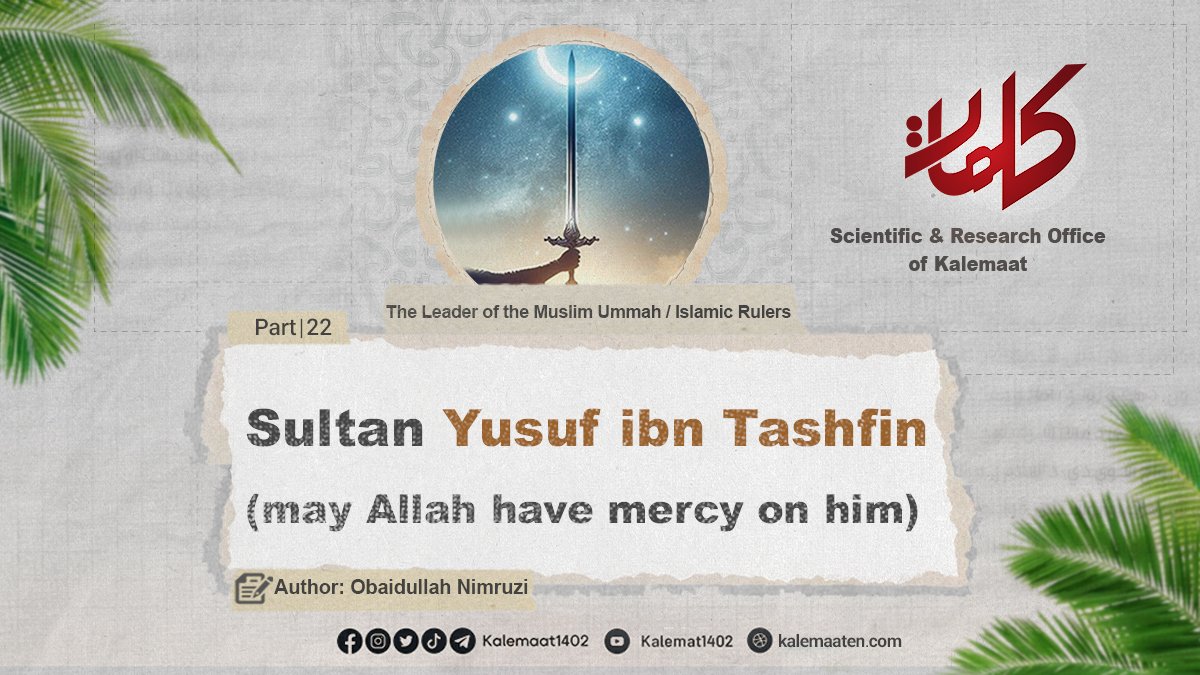Author: Obaidullah Nimruzi
The Guardian of Al-Andalus (Spain): Sultan Yusuf ibn Tashfin [MABH] (Part 22)
The State of the Maghreb on the Eve of the Almoravid (Murabitin) Rise
At the time when the Almoravid dynasty emerged in the Maghreb and Al-Andalus, the political and social conditions in these regions were in turmoil and disarray. Law had lost its force, security had vanished, and the people were trapped in a state of deep instability. In the Maghreb, chaos had enveloped every aspect of life: poverty was widespread, ignorance was prevalent among desert nomads and dwellers, and narrow-minded tribal and regional structures had created fertile ground for destructive activities.
Tribal raids were rampant and unprovoked, and tribal leaders—obsessed with their limited powers—sought to preserve and expand their influence, even at the expense of attacking others. The region suffered from severe political, economic, and religious fragmentation. Deviant ideologies and heretical beliefs were spreading, people were divided into numerous sects and factions, and constant internal strife prevailed—seditions often fueled by oppressive and worldly rulers who had neither faith in their hearts nor awakened consciences.
Political Entities in the Maghreb During the Almoravid Era
Amid this chaos, several unstable local powers and political entities had taken shape in the Maghreb (West), including:
The kings of Taza, from the lineage of Ibn Abi al-‘Afiyah, who ruled in the current Rif region. After fierce battles, they were eventually defeated by Amir al-Muslimin Yusuf ibn Tashfin.
The Zanata tribes, notorious for their oppression and transgressions. Abu Yaqub fought jihad against them and captured a fortress attributed to the Zanata. [1]
Miknasa, governed by the al-Kuzna’i family.
The Wanudin clan in the south, led by Mas‘ud ibn Wanudin, who also controlled the Draa region.
Tamsna, under the rule of the Barghawata tribes, known for their corrupt and heretical beliefs.
Aghmat, ruled by the descendants of Laquṭ ibn Yusuf al-Maghrāwī.
Fes (Fez), which functioned as an independent entity.
Taroudant and its surrounding areas, under the control of the Rafidi Bajaliyya tribe.
The Groundwork for Reformist Movements
In this sorrowful situation, reform efforts led nowhere, as people were immersed in materialism, superficiality, and personal interests. In such an atmosphere, no one heeded warnings, and public will be reduced to the most superficial of daily concerns.
This created a golden opportunity for the enemies of Islam to easily assess the Muslim Ummah weaknesses and prepare for infiltration and looting. Internal divisions and disunity among Muslims stripped the land of its sanctity and paved the way for invaders bent on bloodshed, plunder, the destruction of values, and the silencing of any voice calling for reform.
Yet, even amid all this hardship, if honesty, determination, and a clear path emerge among reformers, victory is inevitable. The banner of monotheism and truth will be raised, wills will be freed, fatigue will dissipate, aspirations will be elevated, and sacrifices will become easy.
The Almoravids (Murabitin): Seeds of Awakening Amidst the Storm
These noble ideals were embodied in the Almoravid movement—a call that awakened the soul of the ummah, unified aspirations, and made unity possible. Even though the desert regions of the Maghreb were brimming with disorder at the beginning of the 5th century AH, a group of sincere believers under the leadership of ‘Abdullah ibn Yasin set out on the path of reform.
With sacrifice and sincerity, they worked to unite the Muslim community, correct beliefs, and establish justice. As a result, the flag of Islam was raised, and unity was achieved. At the forefront of this movement was Yusuf ibn Tashfin, who organized the army, spread Islamic awareness, and restored the lost glory of the Maghreb and Al-Andalus.
Yusuf ibn Tashfin in the Maghreb al-Aqsa
When Yusuf ibn Tashfin was appointed Emir of the Maghreb in the year 435 AH, his primary goal became unifying the tribes and territories of the Maghreb into a single, centralized government. However, realizing this dream was far from easy. He faced strong tribal confederations and widespread deviant Islamic ideologies entrenched in remote and hostile regions that were eager and well-equipped to fight.
Among his staunchest adversaries were:
The Barghawata sect in the Tamsna region, The forces in the regions of Ceuta (Sabta) and Tangier (Tanja),
These areas were under the control of Sukut al-Barghawati, a warlord who possessed a terrifying navy and many fortresses, unleashing destruction upon lands and instilling dread in people’s hearts. [2]
Given these threats, Yusuf ibn Tashfin’s mission was extremely difficult. But when faith is deeply rooted in hearts, the impossible becomes possible. The faith of the Almoravids was so deep and steadfast that it prepared them to confront all the forces of corruption and disbelief across the Maghreb.
They were fully aware of the dangers posed by destructive, heretical ideologies spreading through the land and considered jihad against them a religious obligation. Thus, they seized every opportunity to uproot this ideological disease. When the Amir al-Muslimin rose from the Sanhaja (Mutuna) tribe, his government encircled these false sects like a necklace around the neck. Through justice, he swept away their shadow of tyranny just as soft rain erases the marks of drought. [3]
Faced with a multitude of responsibilities and widespread threats, the Amir al-Muslimin showed deep insight and awareness. He understood that any leniency or hesitation could offer enemies a chance to unite and mount attacks against the Almoravid call.
Therefore, with unwavering resolve, he confronted these dangers, organizing his army by dividing them between defenders of the oppressed and those attacking centers of polytheism and esoteric sects. When Amir Abu Bakr ibn ‘Umar returned once again to the Maghreb Sahara, Yusuf ibn Tashfin summoned the tribes that had joined the Almoravid call and saw jihad as the salvation of the ummah. He structured the army so that each unit had a mission in line with its capability.
Continues…
Previous Part / Next Part
References:
[1] Ali Muhammad al-Sallabi, The Almoravid State, p. 102, Dar al-Ma‘rifah, Beirut, 2002.
[2] Ibn Bassam, al-Dhakhīrah fī Maḥāsin Ahl al-Jazīrah, p. 56.
[3] Ali Muhammad al-Sallabi, The Almoravid State, Dar Ibn Kathir, Beirut, 2002, p. 104.



